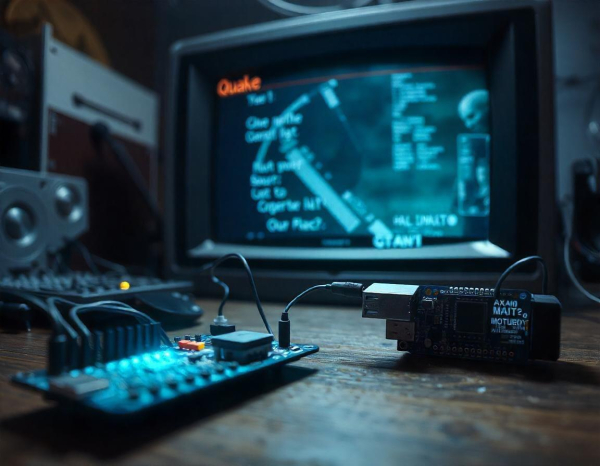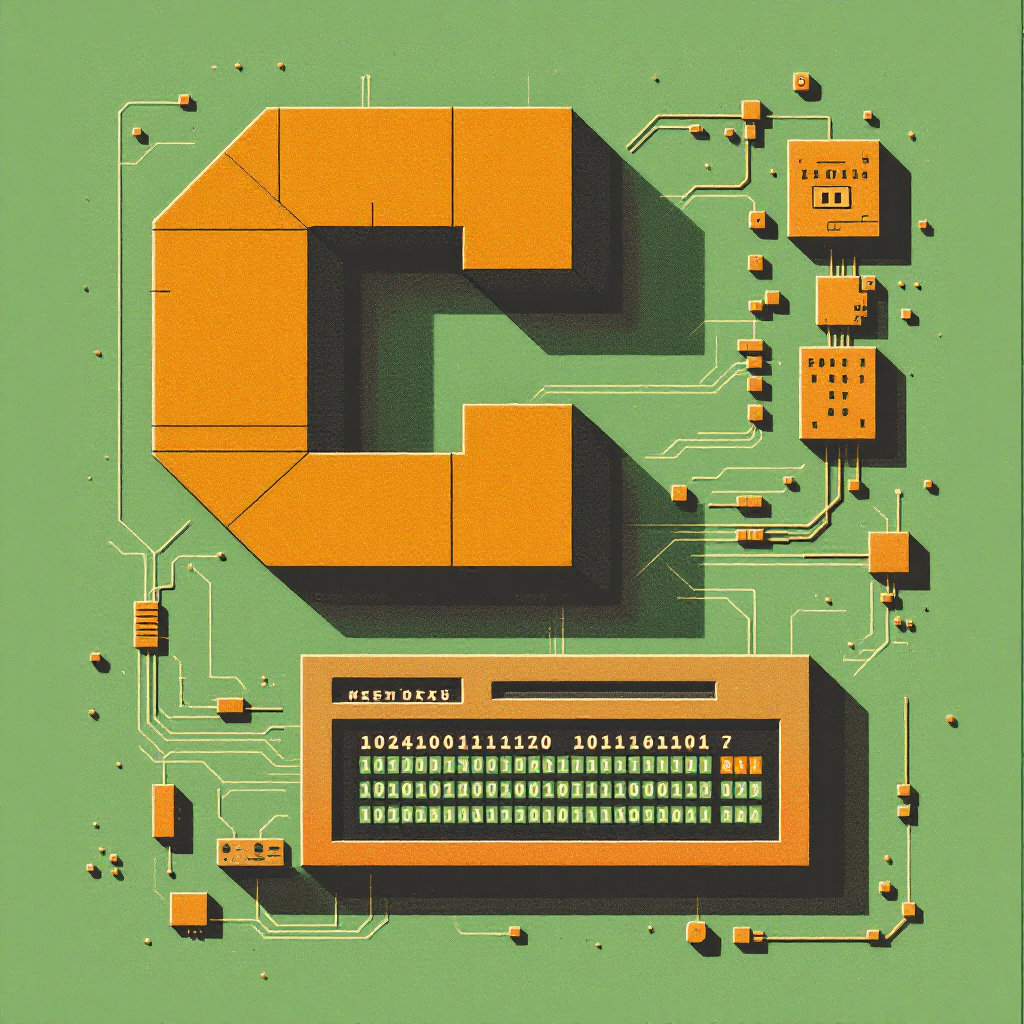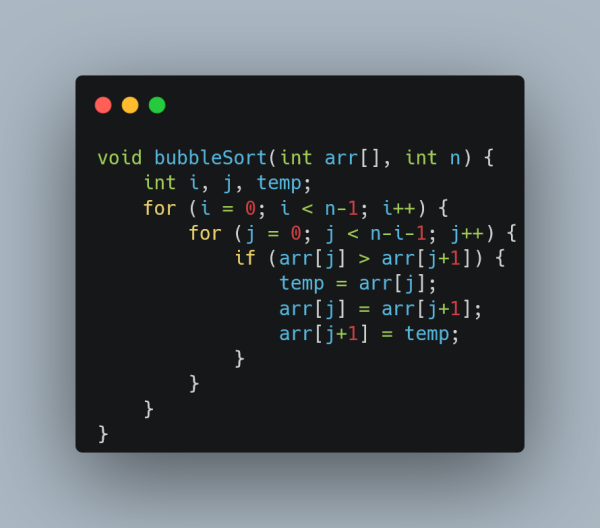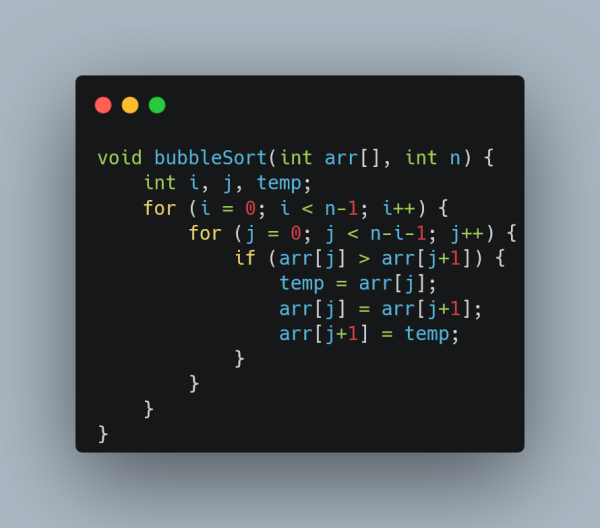Suche
Beiträge, die mit programming getaggt sind
Why Is This Site Built With C
#programming #cprogramming #blog
Check out the step-by-step guide for beginners with clear examples!
👉 Read more here :https://www.spsanderson.com/steveondata/posts/2025-03-26/
#C #CProgramming #Blog #Programming #cprog #learn
Setting Up Data Structures in C: A Complete Guide for Beginners – Steve’s Data Tips and Tricks
“Setting Up Data Structures in C: A Complete Guide for Beginners” provides a comprehensive introduction to C data structures with step-by-step explanations and practical code examples.Steve's Data Tips and Tricks
Fixing slow scrolling in Calendo
In this post, I'll go through the steps which i took to fix a bug with slow scrolling in Calendo. Interested in the development of Calendo? Read my previous post about Building Calendo or search on the Tag: Calendo.Wesley de Groot
 📄 Minimal Linux OS runs in a 6MB PDF Document in Chrome.
📄 Minimal Linux OS runs in a 6MB PDF Document in Chrome.A version of the Linux operating system can now be run inside a PDF opened by a Chromium-based browser. The developer [Ading2210] explains that Linux need a modified version of the TinyEMU RISC-V emulator.
https://github.com/ading2210/linuxpdf
#linux #pdf #chromium #based #browser #it #engineer #media #programming #art #tech #developer #artist #news
GitHub - ading2210/linuxpdf: Linux running inside a PDF file via a RISC-V emulator
Linux running inside a PDF file via a RISC-V emulator - ading2210/linuxpdfGitHub
#Python #Programming #Coding #IT #Tech #Software #computer #Statistics #DataAnalysis #MachineLearning #DataScience #Jokes #Memes #Funny #NeuralNetworks #AI #DevOps
💻
Python Knowledge Base
https://python-code.pro/
Where curiosity meets code – explore our Python knowledge hub today!
Become a Python expert with our comprehensive knowledge base, covering everything from the basics to advanced topics, take your coding to the next level.Andrey BRATUS (python-code.pro)
I want to document the way you might have a possibility to use the same software to make a similar website. @Madiator2011 already done that with blog.madiator.com. Lets go over: where you get the code, how do you set it up, how do you publish, how do you manage accounts, and most importantly, how do you modify everything, so it will look like your own thing.
Read or listen: https://blenderdumbass.org/articles/how_to_make_a_blog_like_mine_using_bdserver_software_
#blog #blogging #webdev #website #python #programming #BDServer
Nicola Wrachien with Silicon Labs created this fun handheld, porting Quake using the Arduino Nano Matter. For easy playing a custom controller shaped board was designed with joysticks and a screen.
https://next-hack.com/index.php/2024/09/22/quake-port-to-sparkfun-and-arduino-nano-matter-boards-using-only-276-kb-ram/
#quake #arduino #nano #diy #handheld #port #retro #gaming #art #maker #engineer #artist #media #programming #tech #news
Key topics:
• Basic syntax
• Input validation
• Menu-driven programs
Check the guide: Reading Keyboard Input in Linux https://www.spsanderson.com/steveondata/posts/2025-03-21/
#Blog #Programming #Linux #Bash 🐧💻
Reading Keyboard Input in Linux: A Beginner’s Guide – Steve’s Data Tips and Tricks
Discover how to add interactivity to your Linux scripts with our comprehensive guide on reading keyboard input. Learn to use the read command in Bash, validate user input, and create menu-driven applications.Steve's Data Tips and Tricks
Key topics:
• Basic syntax
• Input validation
• Menu-driven programs
Check the guide: Reading Keyboard Input in Linux https://www.spsanderson.com/steveondata/posts/2025-03-21/
#Blog #Programming #Linux #Bash 🐧💻
Reading Keyboard Input in Linux: A Beginner’s Guide – Steve’s Data Tips and Tricks
Discover how to add interactivity to your Linux scripts with our comprehensive guide on reading keyboard input. Learn to use the read command in Bash, validate user input, and create menu-driven applications.Steve's Data Tips and Tricks
Build a personal brand as developer
Here are some tips to build a personal brand as a developer. Define your brand Start by defining your brand. Who do you target. What are your strengths and skills. What are your values. Where do you stand for. What are your goals.Wesley de Groot
 GitHub uncovers new Ruby-SAML Vulnerabilities allowing Account Takeover Attacks.
GitHub uncovers new Ruby-SAML Vulnerabilities allowing Account Takeover Attacks.Two high-severity security flaws have been disclosed in the open-source ruby-saml library that could allow malicious actors to bypass Security Assertion Markup Language (SAML) authentication protections.
https://github.blog/security/sign-in-as-anyone-bypassing-saml-sso-authentication-with-parser-differentials/
#github #ruby #saml #library #it #security #privacy #engineer #media #programming #tech #news
Sign in as anyone: Bypassing SAML SSO authentication with parser differentials - The GitHub Blog
Critical authentication bypass vulnerabilities were discovered in ruby-saml up to version 1.17.0. See how they were uncovered.Peter Stöckli (The GitHub Blog)
Read more at https://www.spsanderson.com/steveondata/posts/2025-03-17/
#R #RStats #Programming #DataSci #LearnR #Blog #RPgramming #Loop
For-Loop with Range in R: A Complete Guide with Examples – Steve’s Data Tips and Tricks
Discover how to use for-loops with ranges in R with this comprehensive guide featuring clear examples, best practices, and interactive exercises for both beginners and experienced R programmers.Steve's Data Tips and Tricks
Read more at https://www.spsanderson.com/steveondata/posts/2025-03-17/
#R #RStats #Programming #DataSci #LearnR #Blog #RPgramming #Loop
For-Loop with Range in R: A Complete Guide with Examples – Steve’s Data Tips and Tricks
Discover how to use for-loops with ranges in R with this comprehensive guide featuring clear examples, best practices, and interactive exercises for both beginners and experienced R programmers.Steve's Data Tips and Tricks
Fizz Buzz has just enough complexity to demonstrate a principle that is usually tough to understand through toy examples: the open/closed principle.
https://kerrick.blog/tutorials/2025/fizz-buzz-object-oriented-edition/
#blog #programming #WebDev #SoftwareEngineering #Software #Design #OOP #OpenClosedPrinciple #Metaprogramming #Ruby
Fizz Buzz, Object-Oriented Edition: Exploring the Open/Closed Principle With Polymorphism and Metaprogramming - Kerrick Long's Blog
Learn to use refactoring, object-oriented design, and metaprogramming to trade simplicity for extensibility using Fizz Buzz as a base.Kerrick Long (Kerrick Long's Blog)
#blog #programming #indieweb
https://rm-o.dev/blog/the-indirection-maze/
The feat was devised by Software Engineer Dmitri Mitropoulos, founder of Michigan Typescript and co-founder of Squiggleconf. He released a video showcasing the results of a year-long effort to get Doom running inside of Typescript's Types system.
https://youtu.be/0mCsluv5FXA
#doom #port #typescript #programming #ascii #art #engineer #media #retro #gaming #history #tech #artist #news
NavigationStack
NavigationStack is a framework that provides a navigation stack for macOS and iOS. Navigation was done using NavigationView, but it was deprecated in iOS 16 and was split into two new containers, NavigationStack and NavigationSplitView, and each one …Wesley de Groot
https://yenzenz.com/blog/2025/timezone-importance/
#programming #data #blog
https://mirekdlugosz.com/blog/2025/django-data-modified-in-pre-save-signal-is-not-saved/
#python #django #programming #bugs #blog #software #softwaredevelopment
With beginner-friendly examples! ✨
#C #CProgramming #Blog #Programming #CProg #Arrays
Read more here: https://www.spsanderson.com/steveondata/posts/2025-03-12/
Arrays and Pointers in C: A Complete Guide for Beginners – Steve’s Data Tips and Tricks
Master arrays and pointers in C programming with this beginner-friendly guide. Learn the relationship between arrays and pointers, explore practical examples, and understand memory management for more efficient code. Perfect for new C programmers!Steve's Data Tips and Tricks
With beginner-friendly examples! ✨
#C #CProgramming #Blog #Programming #CProg #Arrays
Read more here: https://www.spsanderson.com/steveondata/posts/2025-03-12/
Arrays and Pointers in C: A Complete Guide for Beginners – Steve’s Data Tips and Tricks
Master arrays and pointers in C programming with this beginner-friendly guide. Learn the relationship between arrays and pointers, explore practical examples, and understand memory management for more efficient code. Perfect for new C programmers!Steve's Data Tips and Tricks
I want to document the way you might have a possibility to use the same software to make a similar website. @Madiator2011 already done that with blog.madiator.com. Lets go over: where you get the code, how do you set it up, how do you publish, how do you manage accounts, and most importantly, how do you modify everything, so it will look like your own thing.
Read or listen: https://blenderdumbass.org/articles/how_to_make_a_blog_like_mine_using_bdserver_software_
#blog #blogging #webdev #website #python #programming #BDServer
 Strap in, get ready for more Rust Drivers in Linux Kernel.
Strap in, get ready for more Rust Drivers in Linux Kernel.Rust is alive and well in the Linux kernel and is expected to translate into noticeable benefits shortly, though its integration with the largely C-oriented codebase still looks uneasy. [The Linux and Rust communities still have some issues to work out.]
https://rust-for-linux.com/rust-kernel-policy
#linux #kernel #memory #safety #rust #drivers #it #security #privacy #engineer #media #programming #tech #news
MacOS Terminal Commands
In this post i'll show you my favorite macOS terminal commands that i use often or find interesting. This blog post is a different kind of post than i usually write, but i hope you like it.Wesley de Groot
Explore the examples ➡️ https://www.spsanderson.com/steveondata/posts/2025-03-10/
#R #Data #Code #RProgramming #Programming #Loops #NestedLoops #Blog
How to Create a Nested For Loop in R: A Complete Guide – Steve’s Data Tips and Tricks
Master nested for loops in R with this comprehensive guide. Learn syntax, examples, and best practices for working with multi-dimensional data structures. Perfect for R programmers from beginner to advanced levels.Steve's Data Tips and Tricks
Explore the examples ➡️ https://www.spsanderson.com/steveondata/posts/2025-03-10/
#R #Data #Code #RProgramming #Programming #Loops #NestedLoops #Blog
How to Create a Nested For Loop in R: A Complete Guide – Steve’s Data Tips and Tricks
Master nested for loops in R with this comprehensive guide. Learn syntax, examples, and best practices for working with multi-dimensional data structures. Perfect for R programmers from beginner to advanced levels.Steve's Data Tips and Tricks
https://samerion.com/journal/2025-02
Read as I explain the problem I ran into while making the last model, and what I aim to do to fix it.
#Samerion #Gamedev #Blog #Programming #3D
Building the hospital for broken textures
It's time to get started with making models for the game! But first, there are some problems I need to tackle. Today, I explain the first steps in creating a model editor.samerion.com
I'm learning as I write it so if you see errors please comment the correction :)
#C #CProgramming #Blog #Programming #LearnC #Code
🔗 https://www.spsanderson.com/steveondata/posts/2025-03-05/
The Complete Guide to C Pointers: Understanding Memory and Dereferencing – Steve’s Data Tips and Tricks
Discover the fundamentals of pointers in C programming, including memory addresses, pointer variables, and dereferencing.Steve's Data Tips and Tricks
I'm learning as I write it so if you see errors please comment the correction :)
#C #CProgramming #Blog #Programming #LearnC #Code
🔗 https://www.spsanderson.com/steveondata/posts/2025-03-05/
The Complete Guide to C Pointers: Understanding Memory and Dereferencing – Steve’s Data Tips and Tricks
Discover the fundamentals of pointers in C programming, including memory addresses, pointer variables, and dereferencing.Steve's Data Tips and Tricks
https://chat-to.dev/post?id=ZjBYSGw1QVE4bElOUThEY2l0OUNYUT09&redirect=/ #programming #forums #blogs #socialnetworks #code #developers

Banned from Forums? Here’s How to Turn the Tables (Ethically, of Course!) 🚀
Ever felt like your controversial opinions got you unfairly booted from forums or microblogs? 🙋♂️ You’re not alone. I’ve been banned from *so many* communities, even though I always tried to play by the rules. But now? I’m done playing nice.Chat-to.dev
What if you want to control a vehicle that’s hundreds of kilometers away, or even on the other side of the planet? Cellular is an option, but is obviously limited by available infrastructure — good luck getting a cell signal in the middle of the ocean.
https://youtu.be/Fjy1hcLf2_M
#diy #remotely #controlled #science #sea #vehicles #starlink #mini #receiver #it #engineer #media #maker #programming #tech #space #news
 Fan made Dreamcast Port of GTA 3 [Steals the Show].
Fan made Dreamcast Port of GTA 3 [Steals the Show].Thanks to [Stefanos] and his team, the genre defining Grand Theft Auto III [GTA 3], can now run on Sega’s hardware. Their combined efforts have yielded a fully playable port of the PC version of the game for Sega Dreamcast.
https://gitlab.com/skmp/dca3-game
#sega #dreamcast #gta3 #port #retrocomputing #art #console #gaming #history #engineer #media #retro #programming #artist #tech #news
Stefanos Kornilios Mitsis Poiitidis / dca3-game · GitLab
A port of librw and re3 to the Dreamcast https://dca3.netGitLab
https://en.wikipedia.org/wiki/Bus_factor
#freesoftware #programming
int mix[] = {42, 13, 7, 1, 89}
Share your solution below! Hint: Start with bubble sort 😉
Join the fun at https://www.spsanderson.com/steveondata/posts/2025-02-26/
#Programming #CProg #Fun #Blog #C #CProgramming
A Beginner’s Guide to Sorting and Alphabetizing Data in C Programming – Steve’s Data Tips and Tricks
Learn how to implement bubble sort and alphabetize data in C programming with our comprehensive guide. Perfect for beginners with step-by-step examples and practical code.Steve's Data Tips and Tricks
int mix[] = {42, 13, 7, 1, 89}
Share your solution below! Hint: Start with bubble sort 😉
Join the fun at https://www.spsanderson.com/steveondata/posts/2025-02-26/
#Programming #CProg #Fun #Blog #C #CProgramming
A Beginner’s Guide to Sorting and Alphabetizing Data in C Programming – Steve’s Data Tips and Tricks
Learn how to implement bubble sort and alphabetize data in C programming with our comprehensive guide. Perfect for beginners with step-by-step examples and practical code.Steve's Data Tips and Tricks


![If you wish to try out the LinuxPDF, it requires a Chromium-based browser to work correctly (I checked, but it didn't work in Firefox on PC).
On the topic of speed and efficiency, [Ading2210] humbly admits that performance might be the largest problem with LinuxPDF. "The Linux kernel takes about 30-60 seconds to boot up within the PDF, which [is] over 100x slower than normal," notes the developer. With Chrome's current PDF engine having its Just-in-Time (JIT) compiler disabled, [Ading2210] sees no way of speeding up the code, for now. If you wish to try out the LinuxPDF, it requires a Chromium-based browser to work correctly (I checked, but it didn't work in Firefox on PC).
On the topic of speed and efficiency, [Ading2210] humbly admits that performance might be the largest problem with LinuxPDF. "The Linux kernel takes about 30-60 seconds to boot up within the PDF, which [is] over 100x slower than normal," notes the developer. With Chrome's current PDF engine having its Just-in-Time (JIT) compiler disabled, [Ading2210] sees no way of speeding up the code, for now.](https://friendica-leipzig.de/photo/preview/1024/810578)
![[ImageSource: Ading2210]
The TinyEMU RISC-V emulator runs in the PDF thanks to a technique where its code is compiled "using an old version of Emscripten that targets asm.js instead of WebAssembly." This is embedded and loads in the PDF, subsequently auto-running a minimal Linux kernel targeting that architecture.
In this implementation, once you agree to 'Start Emulator' in your browser, you will see the LinuxPDF UI load, and a welcome message in the Linux viewport, as you wait for the OS to boot. [ImageSource: Ading2210]
The TinyEMU RISC-V emulator runs in the PDF thanks to a technique where its code is compiled "using an old version of Emscripten that targets asm.js instead of WebAssembly." This is embedded and loads in the PDF, subsequently auto-running a minimal Linux kernel targeting that architecture.
In this implementation, once you agree to 'Start Emulator' in your browser, you will see the LinuxPDF UI load, and a welcome message in the Linux viewport, as you wait for the OS to boot.](https://friendica-leipzig.de/photo/preview/600/810580)
![[ImageSource: Ading2210]
Below the Linux viewport in the PDF is a soft keyboard created by an array of PDF buttons. However, it is likely quicker for everyone with a decent physical keyboard to input commands into the 'type here for keyboard inputs' field to the lower right of the keyboard UI area. [ImageSource: Ading2210]
Below the Linux viewport in the PDF is a soft keyboard created by an array of PDF buttons. However, it is likely quicker for everyone with a decent physical keyboard to input commands into the 'type here for keyboard inputs' field to the lower right of the keyboard UI area.](https://friendica-leipzig.de/photo/preview/600/810582)


![[ImageSource: Nicola Wrachien]
For a much tougher challenge, a group from Silicon Labs decided to port DOOM‘s successor, Quake, to the Arduino Nano Matter Board platform instead even though this platform has some pretty significant limitations for a game as advanced as Quake.
<https://community.silabs.com/s/share/a5UVm000000Vi1ZMAS/quake-ported-to-arduino-nano-matter-and-sparkfun-thing-plus-matter-boards?language=en_US>
To begin work on the memory problem, the group began with a port of Quake originally designed for Windows, allowing them to use a modern Windows machine to whittle down the memory usage before moving over to hardware. They do have a flash memory module available as well, but there’s a speed penalty with this type of memory. To improve speed they did what any true gamer would do with their system: overclock the processor. This got them to around 10 frames per second, which is playable, but not particularly enjoyable.
The further optimizations to improve the FPS required a much deeper dive which included generating lookup tables instead of relying on computation, optimizing some of the original C programming, coding some functions in assembly and only refreshing certain sections of the screen when needed. [ImageSource: Nicola Wrachien]
For a much tougher challenge, a group from Silicon Labs decided to port DOOM‘s successor, Quake, to the Arduino Nano Matter Board platform instead even though this platform has some pretty significant limitations for a game as advanced as Quake.
<https://community.silabs.com/s/share/a5UVm000000Vi1ZMAS/quake-ported-to-arduino-nano-matter-and-sparkfun-thing-plus-matter-boards?language=en_US>
To begin work on the memory problem, the group began with a port of Quake originally designed for Windows, allowing them to use a modern Windows machine to whittle down the memory usage before moving over to hardware. They do have a flash memory module available as well, but there’s a speed penalty with this type of memory. To improve speed they did what any true gamer would do with their system: overclock the processor. This got them to around 10 frames per second, which is playable, but not particularly enjoyable.
The further optimizations to improve the FPS required a much deeper dive which included generating lookup tables instead of relying on computation, optimizing some of the original C programming, coding some functions in assembly and only refreshing certain sections of the screen when needed.](https://friendica-leipzig.de/photo/preview/600/806495)


![[ImageSource: GitHub]
"Attackers who are in possession of a single valid signature that was created with the key used to validate SAML responses or assertions of the targeted organization can use it to construct SAML assertions themselves and are in turn able to log in as any user," GitHub Security Lab researcher Peter Stöckli said in a post.
The Microsoft-owned subsidiary also noted that the issue boils down to a "disconnect" between verification of the hash and verification of the signature, opening the door to exploitation via a parser differential.
Versions 1.12.4 and 1.18.0 also plug a remote denial-of-service (DoS) flaw when handling compressed SAML responses (CVE-2025-25293, CVSS score: 7.7).
⚠️Users are recommended to update to the latest version to safeguard against potential threats.⚠️
The findings come nearly six months after GitLab and ruby-saml moved to address another critical vulnerability (CVE-2024-45409, CVSS score: 10.0) that could also result in an authentication bypass. [ImageSource: GitHub]
"Attackers who are in possession of a single valid signature that was created with the key used to validate SAML responses or assertions of the targeted organization can use it to construct SAML assertions themselves and are in turn able to log in as any user," GitHub Security Lab researcher Peter Stöckli said in a post.
The Microsoft-owned subsidiary also noted that the issue boils down to a "disconnect" between verification of the hash and verification of the signature, opening the door to exploitation via a parser differential.
Versions 1.12.4 and 1.18.0 also plug a remote denial-of-service (DoS) flaw when handling compressed SAML responses (CVE-2025-25293, CVSS score: 7.7).
⚠️Users are recommended to update to the latest version to safeguard against potential threats.⚠️
The findings come nearly six months after GitLab and ruby-saml moved to address another critical vulnerability (CVE-2024-45409, CVSS score: 10.0) that could also result in an authentication bypass.](https://friendica-leipzig.de/photo/preview/600/777841)




![[ImageSource: Dmitri Mitropoulos]
Typescript is a language built on top of Javascript, that add static typing to catch many errant mistakes before your executes, think of it as guardrails which check that functions and other variables are being used correctly. While this is commonly used in all kinds of development, it's unheard of to run a game within Typescript's Type system.
The port itself runs inside three and a half trillion lines of types, totalling a gargantuan size of 177 TB. This is run through Typescript's Type tracker, which takes 12 days to compile the first frame of Doom (0.0000009645 fps). This meant that 20 million type instantiations were running every second in order to get the output.
Mitropoulos explained in the Michigan TypeScript Discord server that this could be improved to take "1 to 12 hours", as long as someone works on it, with the developer noting that he has notes for where potential performance optimizations could be made.
<https://discord.gg/pfKUSmSY>
This was done by running the project within a custom WASM runtime, which is then processed through Typescript within an editor to display a frame.
<https://github.com/MichiganTypeScript/typescript-types-only-wasm-runtime> [ImageSource: Dmitri Mitropoulos]
Typescript is a language built on top of Javascript, that add static typing to catch many errant mistakes before your executes, think of it as guardrails which check that functions and other variables are being used correctly. While this is commonly used in all kinds of development, it's unheard of to run a game within Typescript's Type system.
The port itself runs inside three and a half trillion lines of types, totalling a gargantuan size of 177 TB. This is run through Typescript's Type tracker, which takes 12 days to compile the first frame of Doom (0.0000009645 fps). This meant that 20 million type instantiations were running every second in order to get the output.
Mitropoulos explained in the Michigan TypeScript Discord server that this could be improved to take "1 to 12 hours", as long as someone works on it, with the developer noting that he has notes for where potential performance optimizations could be made.
<https://discord.gg/pfKUSmSY>
This was done by running the project within a custom WASM runtime, which is then processed through Typescript within an editor to display a frame.
<https://github.com/MichiganTypeScript/typescript-types-only-wasm-runtime>](https://friendica-leipzig.de/photo/preview/600/769722)
![Dmitri Mitropoulos further explained that each value within the Typescript Types system equates to a line of pixels [totalling 128,000 lines of pixels in total], resulting in a "resolution" of 320x200, displayed in ASCII.
To do this, the developer needed to remove limitations within the Typescript compiler itself, highlighting just how large the project got, with the Type tracker runtime consuming over 90 GB of RAM while it was running.
This huge overhead meant that common tools within Typescript could not be used, which meant that the herculean task of encoding every element of Doom in types. This required learning to develop elements like an L1 CPU cache, within Typescript Types itself. Due to Typescript requiring iteration on a single string from the left-hand side, binary algorithms had to be input in reverse.
"Oh, and AI can't help" Dmitri Mitropoulos added, describing that the work was so low level that AI couldn't possibly assist with any of the tasks. Too bad, Grok 3.
Mitropoulos said that he undertook the challenge after completing "every other" Types challenge, and wanted to understand why Doom wouldn't be able to run within Types. However, he managed to find "ridiculous" workarounds to make it all work, despite his own disbelief in the project. Dmitri Mitropoulos further explained that each value within the Typescript Types system equates to a line of pixels [totalling 128,000 lines of pixels in total], resulting in a "resolution" of 320x200, displayed in ASCII.
To do this, the developer needed to remove limitations within the Typescript compiler itself, highlighting just how large the project got, with the Type tracker runtime consuming over 90 GB of RAM while it was running.
This huge overhead meant that common tools within Typescript could not be used, which meant that the herculean task of encoding every element of Doom in types. This required learning to develop elements like an L1 CPU cache, within Typescript Types itself. Due to Typescript requiring iteration on a single string from the left-hand side, binary algorithms had to be input in reverse.
"Oh, and AI can't help" Dmitri Mitropoulos added, describing that the work was so low level that AI couldn't possibly assist with any of the tasks. Too bad, Grok 3.
Mitropoulos said that he undertook the challenge after completing "every other" Types challenge, and wanted to understand why Doom wouldn't be able to run within Types. However, he managed to find "ridiculous" workarounds to make it all work, despite his own disbelief in the project.](https://friendica-leipzig.de/photo/preview/600/769724)





![# Inefficient approach (without pre-allocation)
result_inefficient <- c()
for (i in 1:1000) {
result_inefficient <- c(result_inefficient, i^2)
}
# Efficient approach (with pre-allocation)
result_efficient <- numeric(1000)
for (i in 1:1000) {
result_efficient[i] <- i^2
} # Inefficient approach (without pre-allocation)
result_inefficient <- c()
for (i in 1:1000) {
result_inefficient <- c(result_inefficient, i^2)
}
# Efficient approach (with pre-allocation)
result_efficient <- numeric(1000)
for (i in 1:1000) {
result_efficient[i] <- i^2
}](https://friendica-leipzig.de/photo/preview/600/742445)
![# Inefficient approach (without pre-allocation)
result_inefficient <- c()
for (i in 1:1000) {
result_inefficient <- c(result_inefficient, i^2)
}
# Efficient approach (with pre-allocation)
result_efficient <- numeric(1000)
for (i in 1:1000) {
result_efficient[i] <- i^2
} # Inefficient approach (without pre-allocation)
result_inefficient <- c()
for (i in 1:1000) {
result_inefficient <- c(result_inefficient, i^2)
}
# Efficient approach (with pre-allocation)
result_efficient <- numeric(1000)
for (i in 1:1000) {
result_efficient[i] <- i^2
}](https://friendica-leipzig.de/photo/preview/600/742441)



![Modern remote control (RC) radios are capable of incredible range, but they’re still only made for line-of-sight use. But what if you could beam your commands down from space?
That’s what [Thingify] was looking to test when they put together an experimental RC boat using a Starlink Mini for communications. Physically, there was no question it would work on the boat. After all, it was small, light and power-efficient enough.
The downside? Starlink is a fairly expensive proposition; you’d need to have a pretty specific mission in mind to justify the cost. The Mini receiver currently costs $599 USD (though it occasionally goes on sale), and you’ll need at least a $50 per month plan to go with it. While this puts it out of the price range for recreational RC, [Thingify] notes that it’s not a bad deal if you’re looking to explore uncharted territory. Modern remote control (RC) radios are capable of incredible range, but they’re still only made for line-of-sight use. But what if you could beam your commands down from space?
That’s what [Thingify] was looking to test when they put together an experimental RC boat using a Starlink Mini for communications. Physically, there was no question it would work on the boat. After all, it was small, light and power-efficient enough.
The downside? Starlink is a fairly expensive proposition; you’d need to have a pretty specific mission in mind to justify the cost. The Mini receiver currently costs $599 USD (though it occasionally goes on sale), and you’ll need at least a $50 per month plan to go with it. While this puts it out of the price range for recreational RC, [Thingify] notes that it’s not a bad deal if you’re looking to explore uncharted territory.](https://friendica-leipzig.de/photo/preview/600/697102)
![[ImageSource: Thingify]
But would the network connection be up to the task of controlling the vehicle in real-time?
During early ground testing, the Mini version of the Starlink receiver worked very well. Despite being roughly 1/4 the size of its predecessor, the smaller unit met or exceeded its performance during benchmarks on bandwidth, latency and signal strength. As expected, it also drew far less power: the Mini’s power consumption peaked at around 33 watts, compared to the monstrous 180 W for the larger receiver.
On the water, there was even more good news. The bandwidth was more than enough to run a high-resolution video feedback to the command center. At the same time, the boat moved autonomously between waypoints, and when [Thingify] switched over to manual control, the latency was low enough not to be a problem. “We wouldn’t recommend manually piloting a high-speed aircraft over Starlink, but for a boat that’s cruising along at 4 km/h, the lag didn’t even come into play.” [ImageSource: Thingify]
But would the network connection be up to the task of controlling the vehicle in real-time?
During early ground testing, the Mini version of the Starlink receiver worked very well. Despite being roughly 1/4 the size of its predecessor, the smaller unit met or exceeded its performance during benchmarks on bandwidth, latency and signal strength. As expected, it also drew far less power: the Mini’s power consumption peaked at around 33 watts, compared to the monstrous 180 W for the larger receiver.
On the water, there was even more good news. The bandwidth was more than enough to run a high-resolution video feedback to the command center. At the same time, the boat moved autonomously between waypoints, and when [Thingify] switched over to manual control, the latency was low enough not to be a problem. “We wouldn’t recommend manually piloting a high-speed aircraft over Starlink, but for a boat that’s cruising along at 4 km/h, the lag didn’t even come into play.”](https://friendica-leipzig.de/photo/preview/600/697104)
![The porting effort was years in the making. It began with reverse engineering the entire source code of GTA 3 then implementing it into the homebrew SDK for the Dreamcast, KallistiOS. All the in-game graphic and sound assets are only pulled from a user provided PC copy of the game. Steps for those seeking to compile a bootable Dreamcast image of their own have been provided on the project’s website.
<https://dca3.net/setup/>
Recently one of the original developers of GTA 3 [Obbe Vermejj], divulged that the game actually began development on the Dreamcast. The project was obviously transferred onto PlayStation 2 for commercial reasons, but with this port from [Stefanos] and crew, we no longer have to dream of what could have been. The porting effort was years in the making. It began with reverse engineering the entire source code of GTA 3 then implementing it into the homebrew SDK for the Dreamcast, KallistiOS. All the in-game graphic and sound assets are only pulled from a user provided PC copy of the game. Steps for those seeking to compile a bootable Dreamcast image of their own have been provided on the project’s website.
<https://dca3.net/setup/>
Recently one of the original developers of GTA 3 [Obbe Vermejj], divulged that the game actually began development on the Dreamcast. The project was obviously transferred onto PlayStation 2 for commercial reasons, but with this port from [Stefanos] and crew, we no longer have to dream of what could have been.](https://friendica-leipzig.de/photo/preview/600/693069)
![[ImageSource: Stefanos]
As it turns out, Sega’s long defunct Dreamcast console is still thinking. The company behind the machine cut support long ago due in part to the commercial pressures applied by Sony’s PlayStation 2 console, but that never stopped the most dedicated of Dreamcast fans from seeking out its true potential.
This port of GTA 3 represents what could have been a true butterfly effect moment in console gaming history. The game was a major hit in the early days of the PlayStation 2, and it has been theorized that it could have proven to be a major commercial success for Sega as well had it been pressed onto a Dreamcast GD-ROM disc. [ImageSource: Stefanos]
As it turns out, Sega’s long defunct Dreamcast console is still thinking. The company behind the machine cut support long ago due in part to the commercial pressures applied by Sony’s PlayStation 2 console, but that never stopped the most dedicated of Dreamcast fans from seeking out its true potential.
This port of GTA 3 represents what could have been a true butterfly effect moment in console gaming history. The game was a major hit in the early days of the PlayStation 2, and it has been theorized that it could have proven to be a major commercial success for Sega as well had it been pressed onto a Dreamcast GD-ROM disc.](https://friendica-leipzig.de/photo/preview/600/693071)


